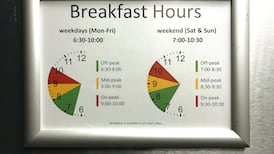Ireland’s housing problem is wrongly characterised as one of undersupply. There will be no solution until this misdiagnosis is corrected.
In economic terms, two features define an undersupplied property market: vacancy rates will be low and real prices and rents will be rising. Neither condition appears to pertain in Ireland.
Every market has an optimal vacancy rate that facilitates the fluid movement of occupiers. If vacancy falls below this, the market is undersupplied. Our Government says the vacancy sweet-spot lies between 2.5 and 6 per cent in a properly functioning housing market, and I have previously estimated the optimum for Ireland at about 5.75 per cent. However, the Census recently measured housing vacancy at 7.85 per cent, excluding temporary absences and unoccupied holiday homes. This does not scream undersupply.
We can challenge the accuracy of vacancy data, but pricing signals cast further doubt on the idea that our housing market is undersupplied. Real house price inflation in Dublin has averaged just 1 per cent a year since March 2019, and negative inflation has been recorded 23 times in the last 50 months, including in each of the last seven. Real property prices are currently falling by 5.8 per cent a year (3.4 per cent nationally), and a similar pattern is evident in the rental market, where there has been negative real inflation since the second quarter of 2022.
READ MORE
Housing output rose by 45 per cent last year, to a level 6.5 times higher than a decade ago. This continued into 2023 with the strongest ever first-quarter completions. The economic signals are telling us that this has been sufficient to meet demand, despite the inflow of Ukrainian refugees and increased Government spending on subsidies for house buyers and renters.
Confronted by this evidence, why is there such a widely-held conviction that Ireland’s property market is undersupplied?
The reason is that our national housing debate has been dominated by sectional interests which benefit from the chronic undersupply narrative. From a commercial perspective, undersupply makes development funding easier to obtain. It also provides leverage for industry representatives to lobby for occupier subsidies that draw out supply by supporting higher prices and rents. Examples include Help to Buy, the First Home Scheme, the Local Authority Home Loan and the Rent Tax Credit, all of which have been introduced, extended or enhanced in the last six months, while mortgage restrictions have been relaxed.
The case that Ireland’s housing market is undersupplied now rests entirely on claims that measured housing output falls short of long-term housing demand forecasts. This is flimsy evidence because such forecasts are entirely notional, relying as they must on assumptions about things that are inherently hard to predict. To illustrate, housing demand is highly sensitive to net migration. This depends on labour market conditions in Ireland, but also in those countries with which we share labour mobility. Unemployment is difficult to accurately forecast in any single country, at short time horizons. At 30 years’ remove, and across multiple countries, it really is guesswork.
Given their motives, industry consultants will naturally adopt assumptions that deliver highball housing demand forecasts. But alternative, equally valid assumptions, will yield much lower estimates. Ironically, however, despite commercially-sourced demand projections being less than authoritative, they are now being put forward as a justification for getting the Government to reopen its home building targets – which were exceeded by 21 per cent last year.
In addition to upscale housing demand estimates there has been a drip-feed of warnings about the construction pipeline. For example, industry representatives have recently warned that viability issues have caused a “large slowdown” in apartment building. It is factual to say viability concerns are discussed within the industry. But it is also a fact that residential commencements over the last six months in Dublin, where apartments account for 84 per cent of the pipeline, are up 31 per cent year-on-year. Meanwhile planning permissions for apartments are up 154 per cent. More generally, the BNP Paribas Real Estate Construction PMI – a survey of building practitioners rather than their representatives – shows that order books, hiring and input purchases are rising at an accelerating pace, and that 88 per cent of construction firms expect to be as busy or busier in one year’s time.
Industry groups are entitled to advance their principals’ agendas. But, in a well-functioning pluralist system, no sectional group would be expected to dominate the debate in the way they have. This has only been made possible by two things. Firstly, Opposition parties have seen political advantage in adopting the undersupply mantra. Secondly, commercial and political motives have been facilitated by a diffident permanent government that shows no capacity for independent analysis and is therefore incapable of leading a high-quality, factually-based dialogue on housing.
[ How to buy your first home in Ireland: The three hurdles to overcomeOpens in new window ]
The evidence suggests that Ireland’s housing problem is no longer undersupply. Today’s problem is high prices and rents relative to incomes, a legacy of undersupply in the past. While this may seem like hair splitting, it has important implications. From today’s starting point, where prices and rents are already falling, targeting further supply increases will propel them down even more quickly. Some would welcome this but, because most households have housing equity, and because banks are providing 90 per cent mortgages, it’s a political non-runner. Therefore, to reconcile its conflicting objectives of increasing supply and preserving property values, the Government will have to channel ever-increasing resources into demand-side supports such as the schemes listed above. In specific terms, this represents an onerous and unnecessary long-term fiscal commitment. More generally, it is another facet of the Irish housing market’s increasing dependence on the State.
Dr. John McCartney is director of research at BNP Paribas Real Estate Ireland, and Adjunct Associate Professor at UCD












